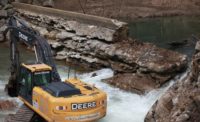A new standard and an updated version of an old standard from the American Society of Civil Engineers are both aimed at clearing up uncertainties around how to handle existing utilities on project sites.
ASCE released the two model standards on July 20: Standard Guideline for Investigating and Documenting Existing Utilities, ASCE/UESI/CI 38-22, and Standard Guideline for Recording and Exchanging Utility Infrastructure Data, ASCE/UESI/CI 75-22. Tom Smith, ASCE’s executive director, said in a statement that the standards would address uncertainty during project development and give more control to design teams.
ASCE 38 was last updated in 2002. It’s intended to serve as both a prescriptive and performance standard, providing necessary steps for documentation as well as guidance for carrying out a utilities investigation with minimal impact on existing utilities, ASCE says. That guidance includes a system for classifying the reliability of utility location information in design plans.
Updates in ASCE 38-22 include new provisions based on lessons from the past two decades since the prior version was introduced, including guidance on collecting and recording utility features, studies on costs, plus commentary and examples. The updated standard also includes guidance for developing 3D-based utility models, new details on utility attributes, as well as new and revised definitions of terms.
The new standard, ASCE 75-22 is the result of recurring discussions going back 30 years around how to ensure new or relocated utilities are accurately recorded in as-builts. It is focused on proper documentation of underground and aboveground utility infrastructure, including their locations, geometry and attributes. The standard includes recommendations on the creation of 3D digital twins for newly installed or newly exposed infrastructure. ASCE says use of the standard applies with both current and emerging digital project delivery practices.
The standard can also be used as a records development model for utility owners, ASCE says.
Both standards are aimed at increasing safety and reducing unexpected costs, according to ASCE. James Anspach, chair of ASCE 38, said both standards will be of use to design managers who need to work around utilities whether they are in active use, out of service or abandoned.
“Record drawings are not always available or of sufficient detail for design purposes,” Anspach said in a statement. “Project coordination is further hampered by utility owners rarely being parties to the project contract.”
ASCE says print copies of the standards will be available starting July 25.






Post a comment to this article
Report Abusive Comment